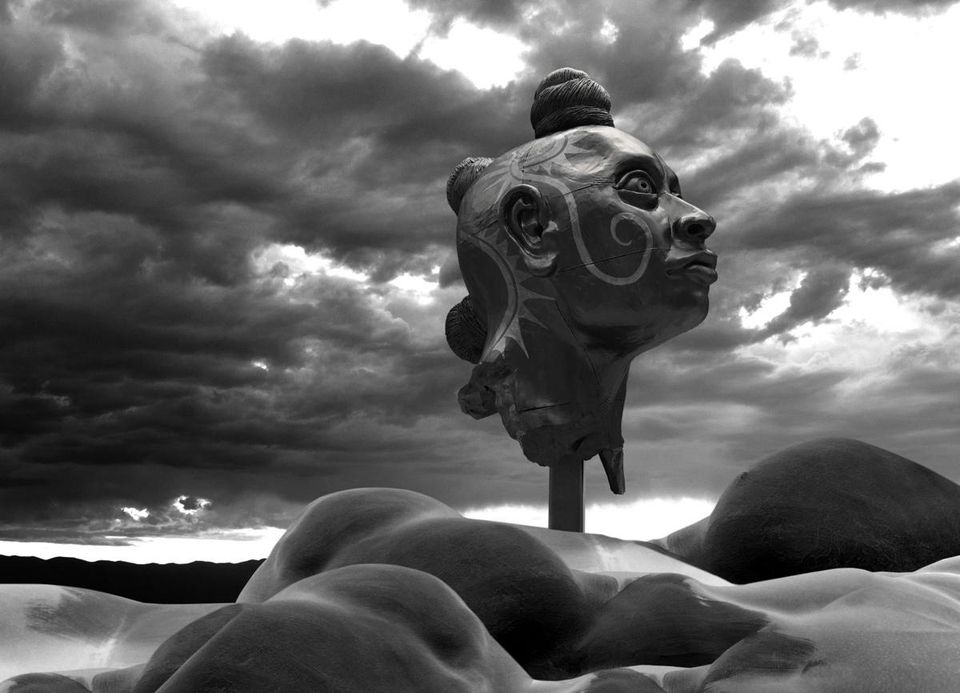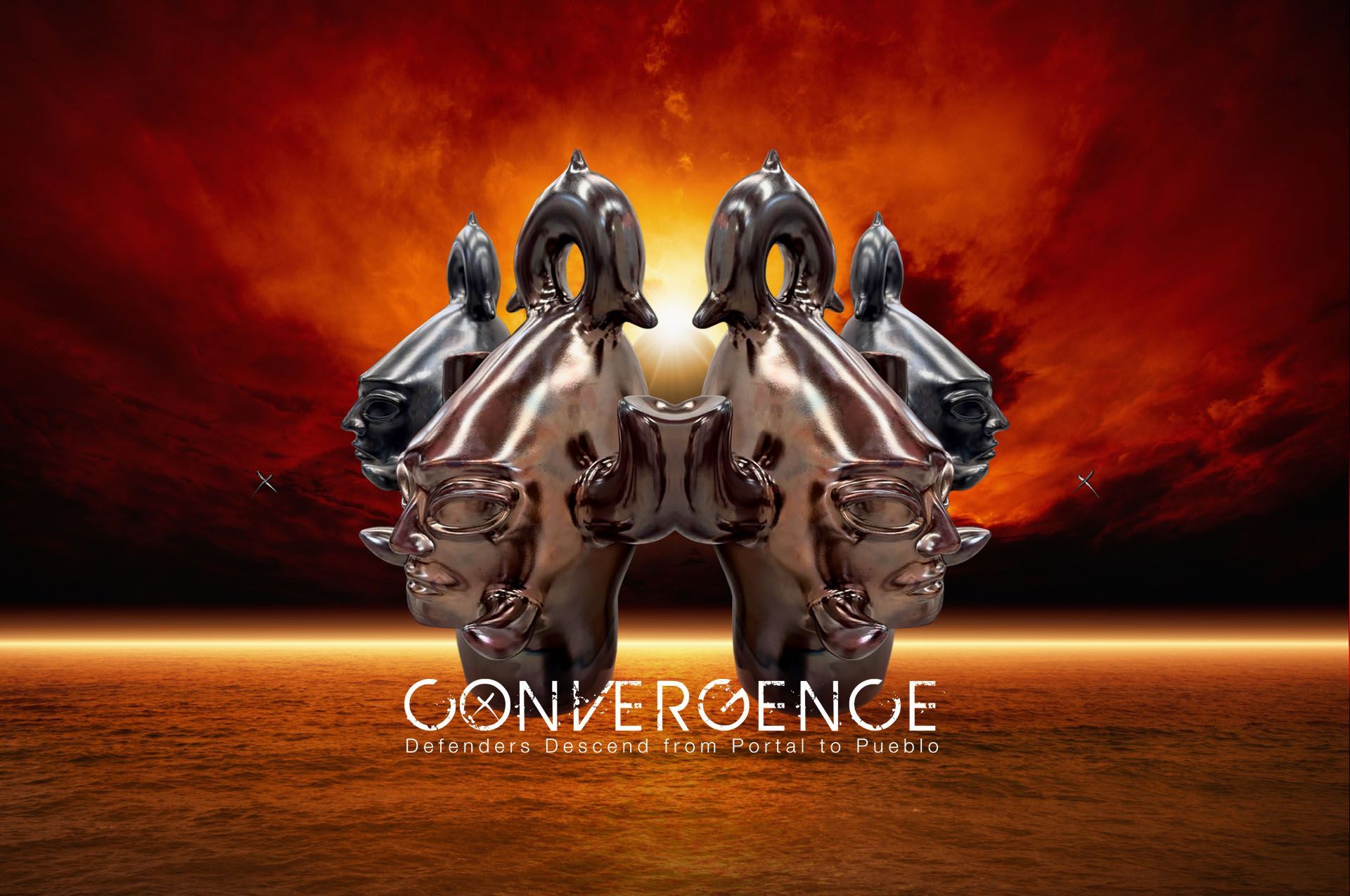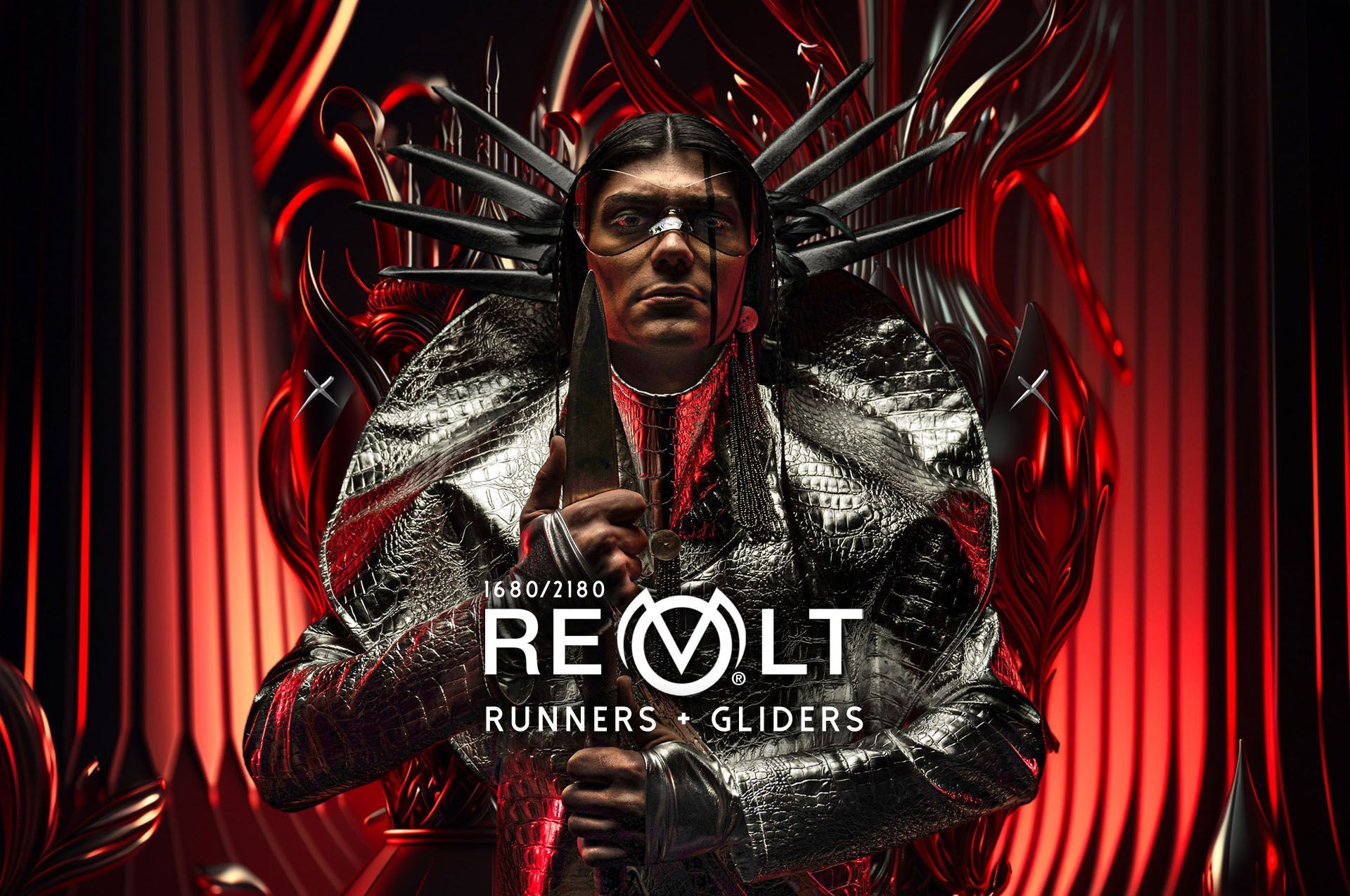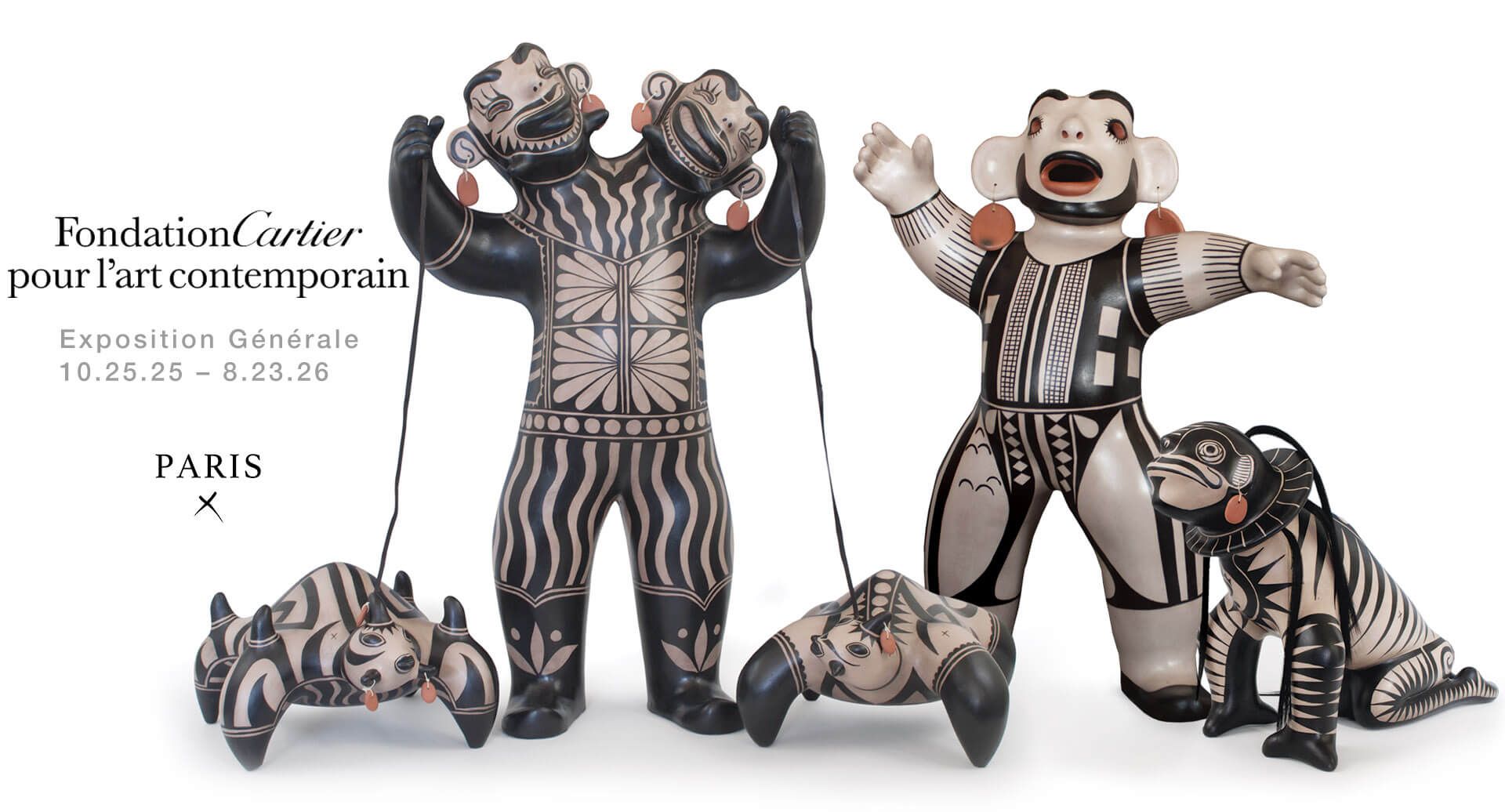
Pueblo artist Virgil Ortiz’s time-traveling pottery is bringing crowds into museums — and Native history into the mainstream.
Virgil Ortiz isn’t afraid to confront or shock. The Cochiti Pueblo artist regularly tackles difficult, even taboo, subjects with his pottery. Blending graphic-comic imagery with time-traveling history and futuristic fantasy, he seems to have hit just the right nerve to make art a popular vehicle for overlooked education. Imagine millennials flocking to see an exhibition about a 17th-century Native American revolt against the Spanish and you’ll have a sense of the sometimes subversive genius at work here.
Raised “with clay in [his] hands” at Cochiti Pueblo between Santa Fe and Albuquerque, New Mexico, Ortiz has made it his artistic focus to tell the story of the 1680 Pueblo Revolt. It is his most ambitious project to date — and one of the least-known events in American history.
The Pueblo Revolt was an uprising of New Mexico Pueblos against the Spanish colonial rulers of the time. Po’Pay of San Juan Pueblo (today known as Ohkay Owingeh Pueblo) organized thousands of pueblos into a simultaneous assault on mission churches and Spanish settlements including the Spanish capital, Santa Fe. Approximately 400 Spanish colonists, including 21 Franciscan missionaries, were killed; the remaining 2,000 Spanish citizens fled New Mexico. Under the command of Don Diego de Vargas, the Spanish retook Santa Fe in 1692, and an uneasy peace descended. After the revolt, the Spanish afforded the Native population more latitude in practicing their religion and culture. However, they were still an occupied people.
“The Pueblo Revolt, the first American revolution, isn’t taught in American schools, nor is it in our history books,” Ortiz says. “My mission of nearly two decades is to create a narrative of the revolt utilizing the various mediums I work with and make it more interesting and relevant to the next generation.”
An Ancient History For A New Generation
Ortiz’s exhibition Revolution — Rise Against the Invasion, on view at the Colorado Springs Fine Arts Center at Colorado College through January 6, is part of the artist’s epic story arc, Revolt 1680/2180, a mash-up of Puebloan history interpreted with sci-fi fantasy iconography relatable to Native and non-Native youth alike. The storyline begins more than 300 years ago when the Spanish colonized the American Southwest. Ortiz transports the viewer forward in time to 2180 and envisions a resolution of the troubling history that restores balance to the multiple cultures that now call New Mexico home. The lead characters are Po’Pay, the real-life leader of the Pueblo Revolt, and Tahu, the imagined female leader. There’s also the Spirit World Army, comprising groups of warriors representing the pueblos involved in the revolt.
The beautiful, evocative Tahu reflects the strength, power, and resilience of the Pueblo women. “Tahu is purposely blinded by the oppressors for her combat prowess,” Ortiz says. “She recruits a ‘spirit army’ and relentlessly battles the enemy [the colonial oppressors]. Tahu is a Pueblo superhero. Her example leads young people to seek the truth and defeat their fear. Tahu is inspired by and honors Pueblo women, including my late mother. Women keep the stories of our people, our traditions, and ceremonies alive. Our mothers teach us to face adversity with a positive outlook. We have endured because we face our fears, both real and imagined.”
Revolution — Rise Against the Invasion continues Ortiz’s exploration of the Pueblo Revolt expressed through ongoing exhibitions of his Revolt 1680/2180 concept. Its theme is one of justice, of reversing the oppression of the Puebloan world by the Spanish occupation. Ortiz’s spirit warriors are rendered in stark black-and-white, sparingly punctuated with vivid color. An AI automaton army of animals representing the mule deer, antelope, and ram recalls Cochiti ceremonies and dance. The denouement of the story arc is seen in Tahu, who clenches a deep red rose between her crimson lips, symbolizing the beauty of living in peace. “Learning to coexist is how we move forward,” Ortiz says. “It represents getting color back in our lives.”
While Ortiz’s imagery is both of the moment and futuristic, his material choices and techniques are deeply rooted in Cochiti pottery tradition. Ortiz says Cochiti potters were known for social commentary in the 19th century; the storytellers have always used the medium to put up a mirror to what is happening in the Pueblo and broader society. Ortiz takes that tradition to another level, delivering his message using sci-fi imagery relatable to young people steeped in American pop culture.
Awareness Through Art
The relationship between comics and ceramics isn’t really surprising. Native artists Jason Garcia (Santa Clara Pueblo), Juan de la Cruz (Santa Clara Pueblo), and Diego Romero (Cochiti Pueblo) use superhero themes and work in a graphic style with a sci-fi influence. John Lukavic, curator of Native Arts at the Denver Art Museum, calls it “indigenous futurism.”
“Artists like Virgil Ortiz are merging their history with modern influences,” Lukavic says. “There’s the sense of control and agency, of creating a future world that could exist from a Native perspective.”
Charles King of King Galleries in Santa Fe and Scottsdale, Arizona, sees more than comic book imagery in the work of Ortiz and other contemporary Native artists. “Pottery, after paintings, is one of the most immediate art forms to be used to create content or a message,” he says. “Social commentary, the environment, and politics have moved from the future to now. There is more immediacy in the voice of the potters. I think it’s a trend of artists claiming their culture, their narrative, the history of the pottery, and its significance.”
A Movie In The Works?
If Ortiz’s work sounds a little like the ethos of Black Panther but in a Native American context, you’re onto something. Both Lukavic and King see parallels between Revolt 1680/2180 and the recent blockbuster movie that sprang from the Marvel Comics series.
Ortiz is hearing the same buzz.
“As a matter of fact, I attended the premiere of Black Panther,” Ortiz says. “I recently presented new work from Revolution at King Galleries in Scottsdale. A recording artist at the opening immediately zoned in on a new piece, literally running toward it, saying, ‘This is it! This is what I’m talking about; this is what Black Panther is like, the same aesthetic and power that the movie has, only it’s another culture!’ So, yes, this is what I have been aiming for, to present the 1680 Pueblo Revolt in a new view and perspective. This allows me to bring a sci-fi setting into my storytelling, a look and feel that has influenced my work since I was a child.”
Turning Revolt 1680/2180 into a major feature film is Ortiz’s ultimate goal. The film industry is interested in the story, Ortiz says, but he wants the movie made on his terms. He has visualized every piece of his futuristic world, down to how the characters look, speak, walk, and behave. “It’s important not to lose control of it,” Ortiz says, “not only so that my story is told the way I want it to be told but because this is my people’s history.”
The Revolution exhibition gives a glimpse into Ortiz’s vision for a feature film, providing a peek behind the scenes at the characters, costuming, musical score, and special effects of his planned film. He created every element, moving among multiple mediums: metal, glass, textiles, digital, video, film, original music, and, of course, pottery, in which he combines traditional Cochiti technique with high-fired ceramics.
The exhibition’s theme and the art itself are a departure from staid museum gallery fare. Revolt 1680/2180 is Ortiz’s calling, his passion, and his life’s work. “This is the impact I want to have on the world around me through art and education.”
Pueblo Polymath
“Virgil Ortiz has been a groundbreaker from the beginning of his career,” says Charles King of King Galleries. “He doesn’t allow himself to be constrained by definitions of Native arts. Virgil does it all — textiles, jewelry, multimedia — and has for 20 years. He is not afraid, and that allows other artists to step through the door and work in a variety of mediums.”
Ortiz has a successful track record of branching out. In 2002, he collaborated with designer Donna Karan on a clothing collection. He has his own fashion line, including jewelry carried by the Smithsonian Institution. He spoke to Disney’s Imagineering team during an ideation event and speaks on the fundamentals of the business of art — specifically, how to protect one’s work — to young artists at the Institute of American Indian Arts in Santa Fe.
Ortiz’s work is exhibited worldwide in museum collections including the Stedelijk Museum’s-Hertogenbosch in the Netherlands, Fondation Cartier pour l’art contemporain in Paris, Smithsonian Institution’s National Museum of the American Indian, Virginia Museum of Fine Arts, and Denver Art Museum. — K.F.
Virgil Ortiz: Revolution — Rise Against the Invasion has been extended through May 19 at the Colorado Springs Fine Arts Center at Colorado College in Colorado Springs. His exhibition TABOO II will open April 27 at King Galleries in Scottsdale, Arizona. AFTERMATH: Venutian Soldiers Odyssey will open September 13 at Montclair Art Museum in Montclair, New Jersey.










